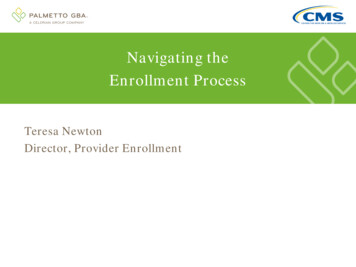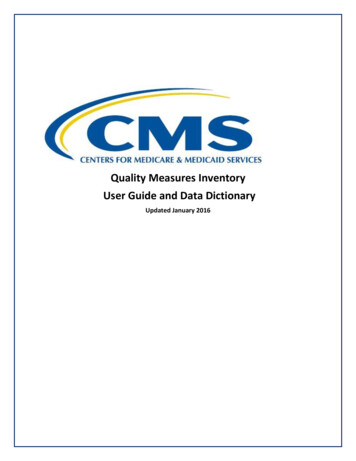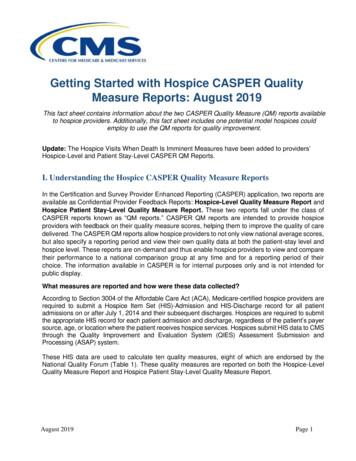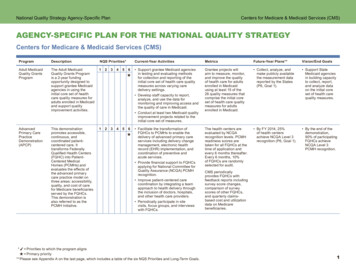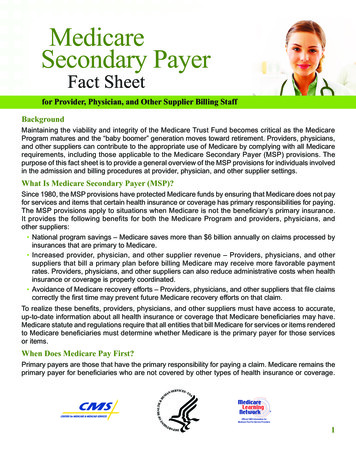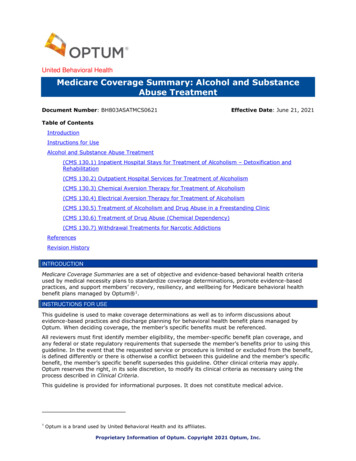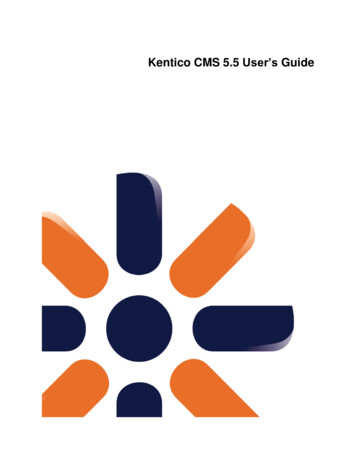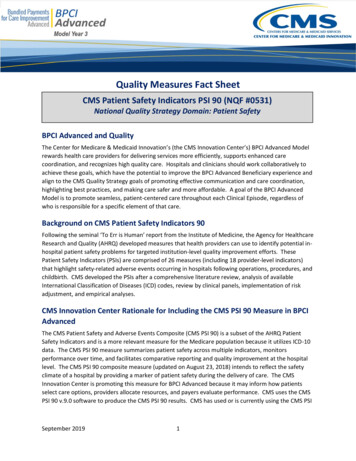
Transcription
Quality Measures Fact SheetCMS Patient Safety Indicators PSI 90 (NQF #0531)National Quality Strategy Domain: Patient SafetyBPCI Advanced and QualityThe Center for Medicare & Medicaid Innovation’s (the CMS Innovation Center’s) BPCI Advanced Modelrewards health care providers for delivering services more efficiently, supports enhanced carecoordination, and recognizes high quality care. Hospitals and clinicians should work collaboratively toachieve these goals, which have the potential to improve the BPCI Advanced Beneficiary experience andalign to the CMS Quality Strategy goals of promoting effective communication and care coordination,highlighting best practices, and making care safer and more affordable. A goal of the BPCI AdvancedModel is to promote seamless, patient-centered care throughout each Clinical Episode, regardless ofwho is responsible for a specific element of that care.Background on CMS Patient Safety Indicators 90Following the seminal ‘To Err is Human’ report from the Institute of Medicine, the Agency for HealthcareResearch and Quality (AHRQ) developed measures that health providers can use to identify potential inhospital patient safety problems for targeted institution-level quality improvement efforts. ThesePatient Safety Indicators (PSIs) are comprised of 26 measures (including 18 provider-level indicators)that highlight safety-related adverse events occurring in hospitals following operations, procedures, andchildbirth. CMS developed the PSIs after a comprehensive literature review, analysis of availableInternational Classification of Diseases (ICD) codes, review by clinical panels, implementation of riskadjustment, and empirical analyses.CMS Innovation Center Rationale for Including the CMS PSI 90 Measure in BPCIAdvancedThe CMS Patient Safety and Adverse Events Composite (CMS PSI 90) is a subset of the AHRQ PatientSafety Indicators and is a more relevant measure for the Medicare population because it utilizes ICD-10data. The CMS PSI 90 measure summarizes patient safety across multiple indicators, monitorsperformance over time, and facilitates comparative reporting and quality improvement at the hospitallevel. The CMS PSI 90 composite measure (updated on August 23, 2018) intends to reflect the safetyclimate of a hospital by providing a marker of patient safety during the delivery of care. The CMSInnovation Center is promoting this measure for BPCI Advanced because it may inform how patientsselect care options, providers allocate resources, and payers evaluate performance. CMS uses the CMSPSI 90 v.9.0 software to produce the CMS PSI 90 results. CMS has used or is currently using the CMS PSISeptember 20191
90 measure in the following Federal programs: the Hospital Inpatient Quality Reporting Program, ValueBased Purchasing Program, and Hospital-Acquired Condition Reduction Program.Applicable Clinical EpisodesThe CMS PSI 90 measure is in the Administrative Quality Measures Set and applies to the followinginpatient Clinical Episodes included in the BPCI Advanced Model: Acute Myocardial Infarction: Medicare Severity-Diagnosis-Related Groups (MS-DRGs) 280, 281,and 282Back and Neck Except Spinal Fusion: MS-DRGs 518, 519, and 520Bariatric Surgery: MS-DRGs 619, 620, and 621Cardiac arrhythmia: MS-DRGs 308, 309, and 310Cardiac Defibrillator: MS-DRGs 222, 223, 224, 225, 226, and 227Cardiac Valve: MS-DRGs 216, 217, 218, 219, 220, and 221Cellulitis: MS-DRGs 602 and 603Congestive Heart Failure: MS-DRGs 291, 292, and 293COPD, bronchitis, asthma: MS-DRGs 190, 191, 192, 202, and 203Coronary Artery Bypass Graft: MS-DRGs 231, 232, 233, 234, 235, and 236Disorders of the liver excluding malignancy, cirrhosis, alcoholic hepatitis: MS-DRGs 441, 442,and 443Double Joint Replacement of the Lower Extremity: MS-DRGs 461 and 462Fractures of the Femur and Hip or Pelvis: MS-DRGs 533, 534, 535, and 536Gastrointestinal hemorrhage: MS-DRGs 377, 378, and 379Gastrointestinal obstruction: MS-DRGs 388, 389, and 390Hip and Femur Procedures Except Major Joint: MS-DRGs 480, 481, and 482Inflammatory Bowel Disease: MS-DRGs 385, 386, and 387Lower Extremity and Humerus Procedure Except Hip, Foot, Femur: MS-DRGs 492, 493, and 494Major Bowel Procedure: MS-DRGs 329, 330, and 331Major Joint Replacement of the Lower Extremity: MS-DRGs 469 and 470; Healthcare CommonProcedure Coding System (HCPCS) 27447Major Joint Replacement of the Upper Extremity: MS-DRG 483Pacemaker: MS-DRGs 242, 243, and 244Percutaneous Coronary Intervention: MS-DRGs 246, 247, 248, 249, 250, and 251Renal failure: MS-DRGs 682, 683, and 684Seizures: MS-DRGs 100 and 101Sepsis: MS-DRGs 870, 871, and 872Simple pneumonia and respiratory infections: MS-DRGs 177, 178, 179, 193, 194, and 195Spinal Fusion: MS-DRGs 453, 454, 455, 459, 460, 471, 472, and 473Stroke: MS-DRGs 61, 62, 63, 64, 65, and 66Transcatheter Aortic Valve Replacement: MS-DRGs 266 and 267Urinary Tract Infection: MS-DRGs 689 and 690September 20192
Measure SpecificationsThe CMS PSI 90 measure selected for BPCI Advanced follows National Quality Forum (NQF) #0531measure specifications. CMS calculates the measure at the hospital level and calculates a weightedaverage based on each of the following indicators: PSI 03 Pressure Ulcer RatePSI 06 Iatrogenic Pneumothorax RatePSI 08 In-Hospital Fall with Hip Fracture RatePSI 09 Perioperative Hemorrhage or Hematoma RatePSI 10 Post-Operative Acute Kidney Injury Requiring Dialysis RatePSI 11 Postoperative Respiratory Failure RatePSI 12 Perioperative Pulmonary Embolism or Deep Vein Thrombosis RatePSI 13 Postoperative Sepsis RatePSI 14 Postoperative Wound Dehiscence RatePSI 15 Unrecognized Accidental Puncture or Laceration RateFor Acute Care Hospitals (ACHs) participating in BPCI Advanced, the CMS Innovation Center will calculateperformance at the hospital level for all Medicare beneficiaries included in the denominator. ForPhysician Group Practices (PGPs), the CMS Innovation Center will calculate the measure as specified atthe hospital level, then weight the measure based on PGP Clinical Episode volume for each ACH where aPGP triggers an episode.Denominator and NumeratorThe table below provides high level descriptions of the numerator and denominator for eachcomponent of the CMS PSI 90. The CMS PSI 90 measure is not limited to BPCI Advanced Beneficiaries.More detailed measure specifications, as well as inclusion and/or exclusion criteria, are in the linksprovided in the “Other Resources” table below, including the “CMS Measures Inventory Tool: PSI 90”and the ten PSI measure ICD-10-CM/PCS specification overviews.MeasureNumeratorDenominatorPSI 03: PressureUlcer RateQualifying discharges with anysecondary ICD-10-CM diagnosis codesfor pressure ulcer stage III or IV (orunstageable).Surgical or medical discharges for MedicareFee-For-Service (FFS) beneficiaries ages 18years and older.PSI 06: IatrogenicPneumothorax RateQualifying discharges with anysecondary ICD-10-CM diagnosis codesfor iatrogenic pneumothorax.Surgical or medical discharges for MedicareFFS beneficiaries ages 18 years and older.PSI 08: In-HospitalFall with HipFracture RateQualifying discharges with anysecondary ICD-10-CM diagnosis codesfor hip fracture.Surgical or medical discharges for MedicareFFS beneficiaries ages 18 years and older.September 20193
MeasureNumeratorDenominatorPSI 09:PerioperativeHemorrhage andHematoma RateQualifying discharges with anysecondary ICD-10-CM diagnosis codesfor perioperative hemorrhage orhematoma AND any listed ICD-10-PCSprocedure codes for treatment ofhemorrhage or hematoma.Surgical or medical discharges for MedicareFFS beneficiaries ages 18 years and older.PSI 10:Postoperative AcuteKidney Injury RateQualifying discharges with anysecondary ICD-10-CM diagnosis codesfor acute kidney failure AND any listedICD-10-PCS procedure codes fordialysis.Elective surgical discharges for MedicareFFS beneficiaries ages 18 years and older.PSI 11:PostoperativeRespiratory FailureRateQualifying discharges with either:Elective surgical discharges for MedicareFFS beneficiaries ages 18 years and older. Any secondary ICD-10-CM diagnosiscode for acute respiratory failure Any secondary ICD-10-PCSprocedure codes for a mechanicalventilation for 96 consecutive hours ormore that occurs zero or more daysafter the first major operating roomprocedure code Any secondary ICD-10-PCSprocedure codes for a mechanicalventilation for less than 96consecutive hours (or undetermined)that occurs two or more days after thefirst major operating room procedurecode Any secondary ICD-10-PCSprocedure codes for a reintubationthat occurs one or more days after thefirst major operating room procedurecodePSI 12:PerioperativePulmonaryEmbolism and DeepVein ThrombosisRateQualifying discharges with a secondaryICD-10-CM diagnosis code forproximal deep vein thrombosis OR asecondary ICD10-CM diagnosis codefor pulmonary embolism.PSI 13:Qualifying discharges with anyPostoperative Sepsis secondary ICD-10-CM diagnosis codesRatefor sepsis.September 20194Surgical discharges for Medicare FFSbeneficiaries ages 18 years and older.Elective surgical discharges for MedicareFFS beneficiaries ages 18 years and older.
MeasureNumeratorDenominatorPSI 14:PostoperativeWound DehiscenceRateQualifying discharges with any listedICD10-PCS procedure code for repairof abdominal wall AND with any listedICD-10-CM diagnosis code fordisruption of internal surgical wound.Discharges for Medicare FFS beneficiariesages 18 years and older with any-listedICD10-PCS procedure codes forabdominopelvic surgery, open approach ORany-listed ICD-10- PCS procedure codes forabdominopelvic surgery, other than openapproach.PSI cerationRateQualifying discharges with anysecondary ICD-10-CM diagnosis codefor accidental puncture or lacerationduring a procedure AND a secondabdominopelvic procedure one day ormore after an index abdominopelvicprocedureSurgical or medical discharges for MedicareFFS beneficiaries/patients ages 18 yearsand older with any ICD-10-PCS procedurecode for an abdominopelvic procedure.Measure SubmissionThe CMS Innovation Center will calculate this measure using Medicare claims data. To better align withthe performance years of the BPCI Advanced Model, the Model uses January 1 through December 31 formeasure calculation. The date of discharge will determine the calendar year in which the claim isincluded.Revisions from the Published SpecificationsThe BPCI Advanced version of this measure uses a two-year period instead of a three-year period. InModel Year 3, the claims data will be collected from January 1, 2019 to December 31, 2020.Composite Quality ScoreThe CMS PSI 90 measure is one component of the BPCI Advanced Composite Quality Score (CQS)calculation. The CMS Innovation Center uses the CQS to adjust a portion of any Positive TotalReconciliation Amount and any Negative Total Reconciliation Amount. The CQS adjustment will notadjust the Positive Total Reconciliation Amount down by more than 10 percent, nor will it adjust theNegative Total Reconciliation Amount up by more than 10 percent. More information is available at theBPCI Advanced websites provided below.Other ResourcesOrganization/ResourceWebsite AddressAgency for HealthcareResearch and Quality(AHRQ) Patient SafetyIndicators ules/psi resources.aspxBPCI i-advancedSeptember 20195
Organization/ResourceWebsite AddressCMS HospitalsInpatient ProspectivePayment (IPPS) FinalRule (August 17, itals-and-theInstitute of Medicine:to Err is SI 03: Pressure wnloads/Modules/PSI/V2018/TechSpecs/PSI 03 Pressure Ulcer Rate.pdfPSI 06: IatrogenicPneumothorax ds/Modules/PSI/V2018/TechSpecs/PSI 06 Iatrogenic Pneumothorax Rate.pdfPSI 08: In-Hospital Fallwith Hip Fracture ds/Modules/PSI/V2018/TechSpecs/PSI 08 In Hospital Fall with Hip Fracture Rate.pdfPSI 09: PerioperativeHemorrhage andHematoma ds/Modules/PSI/V2018/TechSpecs/PSI 09 Perioperative Hemorrhage or Hematoma Rate.pdfPSI 10: PostoperativeAcute Kidney ownloads/Modules/PSI/V2018/TechSpecs/PSI 10 Postoperative Acute Kidney Injury Requiring Dialysis.pdfPSI 11: PostoperativeRespiratory Downloads/Modules/PSI/V2018/TechSpecs/PSI 11 Postoperative Respiratory Failure Rate.pdfPSI 12: PerioperativePulmonary Embolismand Deep VeinThrombosis ds/Modules/PSI/V2018/TechSpecs/PSI 12 Perioperative Pulmonary Embolism or Deep Vein Thrombosis Rate.pdfPSI 13: PostoperativeSepsis ds/Modules/PSI/V2018/TechSpecs/PSI 13 Postoperative Sepsis Rate.pdfPSI 14: PostoperativeWound ov/Downloads/Modules/PSI/V2018/TechSpecs/PSI 14 Postoperative Wound Dehiscence Rate.pdfPSI 15: wnloads/Modules/PSI/V2018/TechSpecs/PSI 15 Accidental Puncture or Laceration Rate.pdfSeptember 20196
International Classification of Diseases (ICD) codes, review by clinical panels, implementation of risk adjustment, and empirical analyses. CMS Innovation Center Rationale for Including the CMS PSI 90 Measure in BPCI Advanced The CMS Patient Safety and Adverse Events Composite (CMS PSI 90) is a subset of the AHRQ Patient

